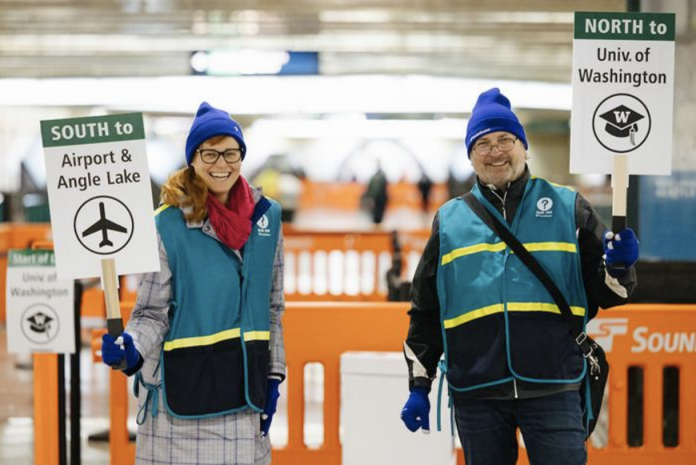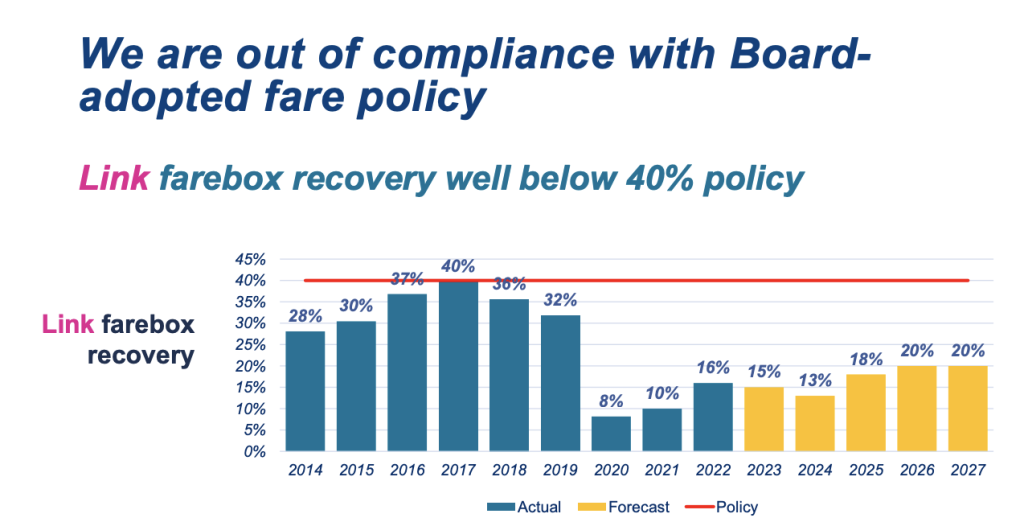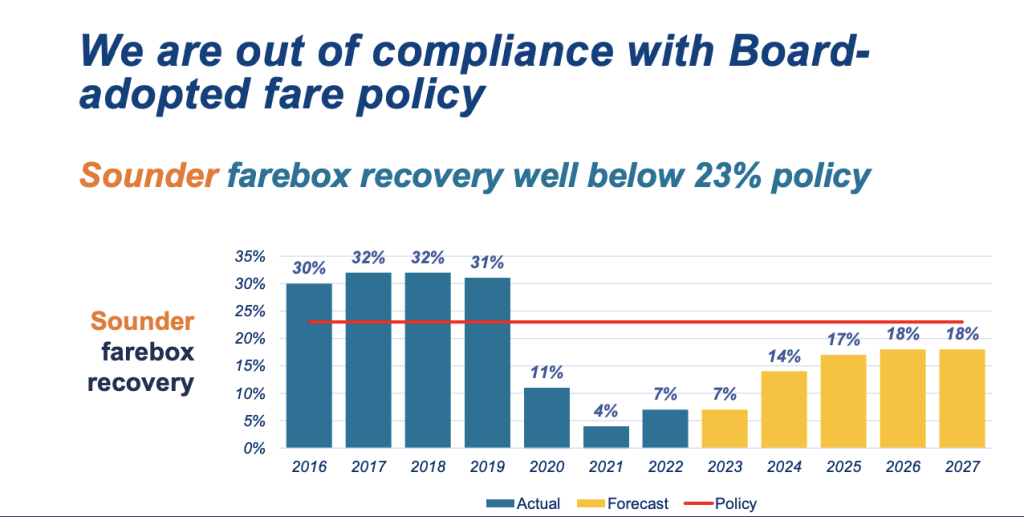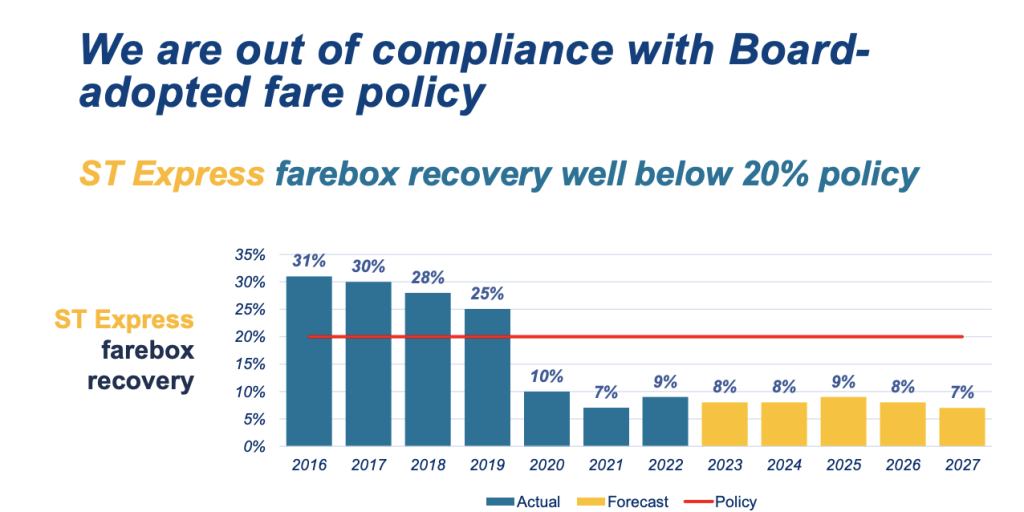Sound Transit’s approach to fares continues to evolve. Earlier this month, agency staff provided a review of the relatively nascent fare ambassador program and a preview of potential changes to fare policies. In that review, staff shared mixed performance of the fare ambassador program. Staffing remains a serious challenge for the program, but surveys show positive views of it and agency staff suggested that it is seeing some successes. The agency’s overall fare strategy could see significant changes this year as farebox recovery targets are adjusted and fare structures get a fresh look.
Fare ambassador program sees mixed performance
Sean Dennerlein, Sound Transit’s Deputy Director of Passenger Experience, provided an update on the agency’s new and evolving fare ambassador program.
The data Dennerlein shared showed that the agency has seen a year-over-year increase in the rate of fare evasion interactions observed through inspections. About 15% of inspections identified non-payment riders in 2022 compared to 10% in 2021, but that may be an oversimplification of the situation. “It’s not necessarily a fair or good comparison to make for either program,” Dennerlein said. “We’ve made drastic changes to it.”
In 2021, there was one fare ambassador for every 75,000 riders. The rider side of that ratio has increased substantially as the agency has struggled to hire staff to fill roles and ridership has boomed. There was about one fare ambassador for every 174,000 riders in 2022. Even with limited staffing though, the number of inspections have gone up with the average fare ambassador conducting 145% more inspections per day in 2022 over 2021.
Dennerlein also said that fare ambassadors are having other successes. “We’re seeing a 30% increase year-over-year in how many conversations around things like OCRA LIFT are happening,” he said. “And so we’re just having a lot more dialogues getting people connected to the appropriate ways to pay fares, things they might be eligible for that they didn’t know about.”
Nevertheless, the 15% fare evasion rate experienced through inspections is about double pre-pandemic levels, and Sound Transit feels that number is accurate. “We can be pretty confident in that number because we have the same type of warning system, same software that calculates this the same way,” Dennerlein said. The agency believes that it has a variety of opportunities ahead to improve the fare compliance rate, such as standing up a new resolution program, using better communications, hiring more fare ambassador staffing, and moving fare paid zones to the surface at downtown tunnel stations.
How fare ambassadors spend their inspections time with riders has changed substantially from the old fare enforcement paradigm. Inspections today take about 30 seconds to verify compliance while warnings and citations are longer at about three minutes to identify the rider out of compliance, issue a warning, and coach the rider on fare compliance options. Under the old fare enforcement paradigm, inspections were expected to take 15 seconds while warnings were expected to take 30 seconds, so staffing needs were about a sixth of what they are today. “We feel pretty comfortable that the 30 second to three-minute is a good ratio for making sure that we are handling every case in a unique and accessible manner,” Dennerlein said.
Right now, the fare ambassador program has just 17 staff members, including supervisors who go out into the field to conduct inspections. Attrition is a big challenge for Sound Transit with the team shrinking to as few as four members at one point last year. The agency had hoped to have 26 members by this point with a goal of staffing up to 46 members by year’s end and further increasing that to as much as 103 members in 2025. It’s going to take a lot of work to get there, but improved recruiting methods may help. One boardmember even made a pitch during the meeting for anyone listening to consider applying.
According to a passenger survey, 80% of respondents said that they were very satisfied with the current fare ambassador program. Another 17% said that they were satisfied or somewhat satisfied while just 3% said they were not at all satisfied. That’s a big improvement from Sound Transit’s last check-in on the issue when 64% of respondents said that they were very satisfied.
Fare strategies could see big overhaul this year.
Sound Transit will be engaging on further fare issues in the coming year. Big topics will be the agency’s fare policy, including fare structures and farebox recovery targets, and expanding paid parking.
The last update to the agency’s overarching fare policy was in 2014. As a result, Sound Transit has two approaches to structuring fares, which include: zone-based fares for geographic areas (ST Express buses and T Line streetcar) and distance-based fares (Sounder and Link 1 Line). The agency also has specialized fares for low-income, disabled, and senior riders.
If no change is made to the fare structure, the cost of a 1 Line trip could range from $2.25 to $4.25 with the opening of the Lynnwood, Redmond, and Federal Way Link extensions. “This future complexity is one of the primary policy issues we hope to engage the board on, and specifically about whether we should consider removing distance-based fares for flat fares,” said Alex Krieg, the agency’s Director of Access, Integration, and Station Area Planning.
There are potential benefits in a transition to flat fares. Distance-based fares require riders to tap on and then tap off to deduct the lowest fare from their ORCA e-purse account. Failure to tap off means that a rider will be charged the highest fare for a service from the origin station. Flat fares eliminate the need to tap off at the end of a trip. Krieg also mentioned that, “A simplified fare structure may allow for a potential transition to fare capping, which caps the total fare a passenger might pay on a daily or monthly basis after they hit a certain threshold.”
Farebox recovery rates are the proportion of operating expenses that are covered by income directly from riders. Farebox recovery rates by service are very different, but all of them are well below targets and not expected to reach them anytime soon:
- Link’s farebox recovery target is 40%. Only one year, in 2017, was that rate achieved. Rates fell in the following years and the pandemic drove the numbers even lower. In 2022, Link only managed to rebound to a 16% farebox recovery rate. That is projected to undulate through 2027 to around 20%.
- Sounder’s farebox recovery target is 23%. It was exceeding that consistently prior to the pandemic at around 30% to 32%. In 2021, Sounder farebox recovery rates bottomed out at 4% and hit 7% in 2022. Projections only suggest an 18% farebox recovery rate in 2027.
- Similarly, ST Express has a 20% farebox recovery target and consistently outperformed that prior to the pandemic. It bottomed out at 7% in 2021 and reached 9% in 2022, but the projections suggest this may fall back to 7% by 2027.
Krieg said that the agency’s board should consider adjustments to targets given new realities. This is because Sound Transit’s financial plan is directly tied to assumed farebox recovery rates. If the reality doesn’t match up with targets, that could mean budget shortfalls. “Farebox recovery below the minimum recovery targets signals that fare revenues are not keeping pace with costs of operations and that the financial plan is threatened,” he said.
Krieg also added, “Another critical point is that the financial plan does assume periodic fare increases. For context, the last Link fare increase occurred in 2015 and a planned fare increase in 2020 did not move forward as a result of the pandemic, which just functionally means fares on Link have not changed.”
The projections are based upon various factors, such as assumed fare compliance rates, ridership levels, and fare rates themselves.
According to agency policy, falling below the farebox recovery rate targets should trigger a fare change process. But changing fare structures and fare rates alone are unlikely to help Sound Transit reach the farebox recovery targets, so a bigger policy process of reconsidering targets, too, is critical.
Additionally, Krieg touched on daily paid parking at the agency’s many park-and-ride facilities. A new parking fee could be imposed that affects some riders. How it might be implemented is an open question given that parking demand is considerably lower than pre-pandemic times (43% parking utilization in October 2022 compared to 95% in October 2019), but some parking facilities that the agency controls are quite full on weekdays. Krieg also noted that ridership could be more sensitive to parking prices now given the flexibility of remote work.
Ultimately, the agency has a lot to tackle on the fares front this year. Deeper dives into fare policies are expected to come before the agency board in spring with public outreach to follow in summer. The board will then have the opportunity to take action on changes later in fall or winter.
Stephen is a professional urban planner in Puget Sound with a passion for sustainable, livable, and diverse cities. He is especially interested in how policies, regulations, and programs can promote positive outcomes for communities. With stints in great cities like Bellingham and Cork, Stephen currently lives in Seattle. He primarily covers land use and transportation issues and has been with The Urbanist since 2014.






